- Getting around Lijiang. Dont stay in the Old Towns more than 2 days, there is nothing to do. KRISS Oct 9, 2013 05:46
- 2013 Beijing Temple Fair BENNYLAU Feb 26, 2013 03:29
- Malaysian traveling from KUL - LAX vis Shanghai PVG ZATI_DY Jan 3, 2013 20:15
In Defence of Taoping
- Views: 5412
- |Vote: 0 0
- |Add to Favorites
- |Recommend to Friends
It has been hot all day. The warmest so far on this fast paced road trip and I’m enjoying the sun on my skin through the open window. Nothing but spectacular scenery has held my attention since we boarded the bus this morning near Maerkang. Hours into the journey, it’s almost full when we make another stop to pick up passengers.
Preoccupied with rearranging backpacks and bicycle wheels to make room for them, we almost miss this comment ‘Laowai xiang yao xia che!’ Since I’m the only one on the bus who fits the description we realize that it must be our destination. Quickly grabbing our packs we hurry down the aisle as the bus begins moving off.
A small untidy village chokes the road. The valley is dry and dusty and uninviting. Cars and tourist buses pack the empty space between the river and the road. Their numbers are testimony to Taoping having been discovered. The village is just twenty minutes from the county seat of Wenchuan and an easy day trip from Chengdu albeit over some of the roughest roads in the west.
Taoping is rather like a ‘diamond in the rough’ – a precious gem that might easily be overlooked. At first glance there’s not much to see and the mountains while spectacularly tall are nude grey and sharply outlined against the clear blue sky. A few trees and rambling potted flowers add a splash or two of colour. The scene is otherwise a dull canvas of monotones.
I’m barely off the bus before we are touted by a plump middle-aged woman in the traditional local dress. It’s a Golden Week so the dollar signs are popping up like jackpots on ‘one-arm bandits’ in a Las Vegas gaming room. With only one way into the village these days – via the tourist trap – we have little choice but to pay the price even if we want to stay the night. My ever resourceful Wu Yi manages to get me a teacher’s discount with no ID and passes herself off as my ‘guide’.
My ticket includes a minute map outlining 10 significant sites – if I could read it – all in Chinese of course. The most significant and of course impossible to miss is a tourist company’s security boom gate at the bridgehead.
With just one ticket in hand we cross the bridge - not simply into the village but into another world – another time. This one is centuries old where very little has changed for thousands of years. With the mid afternoon sun warming our backs we follow the woman in her colourful clothing up the windy dirt road and around to the right of the village that blends roughly into the mountainside from which it has been hewn.
We follow her as she disappears through a small doorway, across her hearth and up a ladder where she shows us several rooms on different levels, all with clean white sheets on single beds in simply furnished rooms. We take the last ladder to the roof in search of one more room.
Emerging once again into the daylight we stand on the mud roof surveying the scene before us. A few paces further and we find ourselves standing on the roof of yet another of these co-joined four story timber, mud and stone houses. In the corner of its courtyard rises one of Taoping’s three remaining stone towers – one of the towers for which the village is now famous and exactly what we have come to see.
A few more inquiries followed by an assurance that we did not agree to stay in the other ladies home, we are accepted by the Wang family. We learn that they have lived here, members of the same clan for 2000 years - currently fourteen members representing four generations. Their home is one of the largest and open to the public free of charge to wander through at leisure. With more than four levels and countless rooms, corridors and stairways, roof gardens and the tower, it is a fascinating living museum of the Qiang minority.
The non nomadic Qiang settled in these mountainous regions more than 2000 years ago. Each village, many of them built on mountain tops or ridges is dominated by a towering square stone lookout, which in the past guarded their homes during periods of often violent conflicts through the centuries. The towers with internal ladders have lookouts on two of the upper most levels offering commanding 360° views.
The Taoping Qiang speak their own unique language, just one of more than ten language groups that make up the Qiang minorities scattered throughout the secluded and rugged foot hills of the Tibetan Plateau.
Despite being late afternoon we have several hours to explore before dark. We choose a room on the third floor roof garden beneath the tower and slip out of the house via the network of underground passageways that connect most of the houses and the other two towers.
Our first stop is the second tower up the slope and it is here that I discover my gate ticket covers nothing but the entry fee to the village. While his fee is only Y2 the man is quite intent on selling the kind of souvenirs that can be found almost anywhere in southern China these days. We skip his tower since we will be sleeping in the shadow of the largest tower in the village and will have it completely to ourselves.
From the valley floor the village looks a little grim, with few trees gracing the upper slopes but a small stream supplying the village with its running water gushes down the mountainside to the left of the village supporting a grove of large trees creating a natural arbor. A small teahouse and BBQ restaurant is located here. Further down the slope the village square comes alive with music and dancing after dark.
At the top left corner of the village is the old grain-mill beside a collection of homes, one selling antiques, artifacts and endangered animal skins while others offer bed and breakfast. A stone stairway up the mountain boasting a better view also costs another Y2.
Not much to pay you might say but from the other side of the village the same view – no a better view in fact – especially at sunset can be had for nothing extra. As darkness falls we find ourselves to the west of the village as high as we have been able to get. It’s a wonderful place to photograph the towers with the setting sun behind them.
A friendly landlord invites us to come up onto his roof garden where we get an even better view. It is guaranteed to be quiet – no early morning tourists to disturb your peace – with access to the steep mountainside behind the village for a better view. This would be an ideal guesthouse offering the best view of both the rising and the setting of the sun over Taoping.
Now there was one more thing that was also not included in my ticket price. The ‘Underground Water Tour’ is not really about the water system but rather more about the Yang family home – and they are aggressive in their approach to their Y2 fee. Grandma rudely questioned me? Had I paid? I could hardly sneak into a place like that but I had grumbled about it the afternoon before. Who was really benefiting from the main gate’s hefty ticket revenues?
The Yang stone house with it’s timber interior is a maze of rooms over four levels but what makes it of interest are the 72 doors – one for each of the crafts or trades of a village - enabling people to move through the house from room to room without once retracing their steps.
The focal point of each of these homes is the entertainment room with a huge fireplace in the center with seating around the walls. Since it is cold for most of the year this room would often have a fierce fire burning. Overhead hangs a timber board with a thin stone slab lying on top. This served two purposes – the first to keep the rain and snow from falling onto the fire through the open roof and second to put out the fire should it get out of hand, burning through the timber that would release the stone slab. If it didn’t actually put the fire out, it would at least alert the sleeping residents that they had a fire.
Even with a few modern concessions the village has changed little despite the increasing numbers of visitors in the past ten years. Our young host is celebrating her wedding during this May holiday but like most of the married women in the village her husband will return to work in nearby Maerkang leaving her here with her parents and older sister to run this family restaurant, rice wine distillery and guesthouse.
We eat our supper in the family dining room and I discover later that the family eats all their meals in the huge kitchen. Joining them after dinner I am invited to sample some of the family brew which we can hear - it sounds like frogs croaking after the rains - brewing in large covered glazed urns on the ground floor beneath the restaurant.
A goatskin, its scalp caked with blood is draped to dry over the handrail while finished goatskin vests hang from the mezzanine floor above the small family living room. Each room is furnished with simple but ornate traditional timber furnishings.
One of the most intriguing things about the village is the house keys. These consist of a slat of timber about 30 centimeters in length and about 4 cm in width. Each then has two or more small dowels protruding from one end of the flat edge. Beside each of the external and internal doors is a hole in the stonework where the key is pushed into the side of the door to lock or unlock. Each key is unique - just like modern keys – unlocking only one door.
Truly an impregnable location overlooking this stunning valley ensuring that an enemy would be challenged to surprise these resourceful people. If indeed they were surprised they still had recourse to secret underground passages to slip away unseen.
Getting there:
Bus from Chengdu to Wenchuan or catch the Maerkang bus and get off in Taoping
Minivans from Wenchuan to Taoping Y5 takes 20 mins (outside bus station)
Minivans from Wenchuan to Dujiangyan Y20 takes around 90mins (outside bus station)
Accommodation:
Several guest houses in the village are not difficult to find especially the one with the watch tower.
Expect to pay Y40/50 for DBB and clean but basic rooms
Be warned that a large tourist hotel is under construction nearby
Entrance fee: Y58
There are many similar villages with stone houses and watch towers in the Wenchuan and Maerkang regions



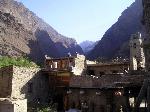
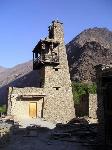
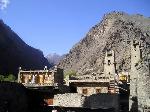
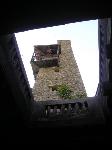
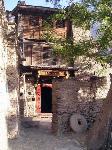
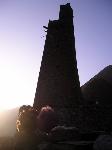

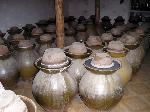
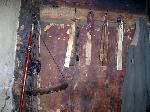
 Copyright © 1998-2026 All rights reserved.
Copyright © 1998-2026 All rights reserved.
1.
May 14, 2008 02:06 Reply
JABAROOTOO said:
This is one of the villages in the May 12 2008 Earth quake zone less than 30kms from the county seat of Wenchuan.
A beautiful village with beautiful people. Just one of many similar villages that dot the torturous terrain in western Sichuan.